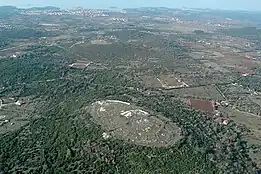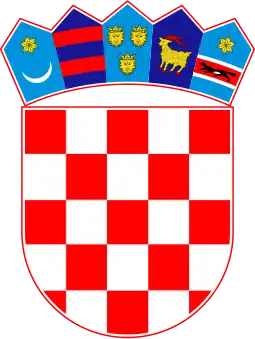
Monkodonja is a hillfort occupied about 1850/1750-1500/1450 BC during the Bronze Age,[1] located near the city of Rovinj in the Croatian region of Istria.[2][3]
Description

The hillfort is located on an elevation, 81 m above sea level, and shows the form of an irregular ellipse stretching east-west with a length of 250 m and a width of 160 m. The settlement was surrounded with three concentric walls and two entrances that have been explored so far (so called Western and Northern Gate).[4] The walls are dry stone constructions. The Cyclopean masonry is reminiscent of the Mycenean architecture. Not far from the Northern Gate there is a cave, more than 50 m deep. Bronze Age pottery and a neolithic burial were discovered in the cave. Bronze Age cist graves were found in the Western Gate. The defensive wall surrounding the settlement was about 1 km long, about 3 m wide and at least 3 m tall. The stone for the walls was quarried directly from the hill, and its removal resulted in the creation of a flat plateau. Approximately 1,000 people lived in the well-organized settlement: on the highest part was the acropolis, below it the upper town and still lower the lower town. The acropolis, where the upper class of the population lived, had a nearly rectilinear outline. In other parts of the settlement there were crafting areas. The houses differed with the position, size and manner of construction, and they were separated by passages and streets. The houses were equipped with hearths and within them were found numerous fragments of handmade pottery that originated from local workshops. Monkodonja was an important point in the communications of the northern Adriatic with Central Europe and the Aegean.[5][6] Findings of so-called loaf-of-bread idols (or tavolette enigmatiche or Brotlaibidol) evidence of the integration into a far-reaching Bronze Age communication network.[7][8]
The settlement was abandoned in the middle of the 15th century BC after a military event in which parts of the buildings burned down. Monkodonja was not inhabited during the Late Bronze and Iron Ages. A silver denarius of Emperor Augustus dating 13 BC indicates sporadic visits to the site during the Roman Empire.[9]
Excavations
It was discovered in 1953 by B. Baćić and B. Marušić. The first research was carried out in 1953-1955. Between 1997-2009, contemporary multidisciplinary international research has been conducted under the leadership of Bernhard Hänsel, Kristina Mihovilić and Biba Teržan (Freie Universität Berlin, Archaeological Museum of Istria in Pula - Arheološki muzej Istre, University in Ljubljana).
The settlement system
The Monkodonja hillfort is surrounded by numerous smaller fortified settlements. Between the settlements a visual communication is possible. Monkodonja is seen as the central settlement in the settlement system. Large quantities of food were delivered to the settlement and stored in large storage jars protected by the strong fortifications. However, it is not yet clear if the surrounding settlements were depending on Monkodonja as would be the case according to the Central place theory by Walter Christaller.
The graves in the Western Gate
The Wester Gate of Monkodonja was modified and reinforced over several centuries. In the course of the excavations, two stone cist graves were discovered on the left and right side of the gate lane.[10] Stone cist A was set in a square pedestal and contained bones from numerous individuals. The remains are not anatomically complete. Radiocarbon dates suggest that the earliest burials in stone cist A date back to before 2000 BC, thus before the settlement of Monkodonja was established.[11]The youngest radiocarbon date falls into the 17th century BC. Stone cist A also contained grave goods, jewelry made of bronze wire and bronze sheet, as well as reddish-orange beads possibly imitating amber. Another stone cist, stone cist B, was found in a corner construction of the wall on the other side of the gate lane. As with stone cist A, people had been buried in this grave for a long time, although the skeletons, with the exception of one individual, are not anatomically complete. Radiocarbon dating of the bones shows that the stone cist was used between the 21st and 17th centuries BC.
The burial mounds
Near Monkodonja, about 1 km south-east, lies the Monsego or Mušego hill, where several stone burial mounds were discovered.[12] It is assumed that Monsego was Monkodonja's cemetery. However, only part of the population was buried in the stone cists under the stone burial mounds. For the majority of the Bronze Age population we do not know what their graves looked like or where they were located. The skeletons in the stone cists are not anatomically complete, which means that the remains of the deceased were not placed in the grave in their entirety. As in Monkodonja, grave goods in the form of bronze jewelry and several amber beads were found in the stone cists.
Europa Nostra Award
In 2002, research in Monkodonja was awarded with the Europa Nostra Award.[13] The exemplary excavations, in which the walls were reconstructed in situ parallel to the excavation work, were acknowledged. Today the excavation site is open to tourists as an Archaeological Park.[14]
Literature
Bernhard Hänsel, Kristina Mihovilic, Biba Terzan: Monkodonja: Istraživanje protourbanog naselja brončanog doba Istre. Knjiga 1—Iskopavanje i nalazi građevina/ Monkodonja: Forschungen zu einer protourbanen Siedlung der Bronzezeit Istriens. Teil 1—Die Grabung und der Baubefund. Monografije i katalozi Arheološki muzej Istre 25, Pula 2015, Pula 2015, ISBN 978-953-6153-92-3.
Gallery
 Aerial view
Aerial view Remains of the acropolis
Remains of the acropolis Remains of the fortifications
Remains of the fortifications.JPG.webp) Walls of Monkodonja
Walls of Monkodonja.JPG.webp) Pavement
Pavement.JPG.webp) Entrance
Entrance.JPG.webp) Cult cave near Monkodonja
Cult cave near Monkodonja Monsego, tumuli
Monsego, tumuli
References
- ↑ "Forschungsgrabung Monkodonja, Gem. Rovinj, Istrien/Kroatien". Institut für Prähistorische Archäologie. Freie Universität Berlin. 16 November 2007. Archived from the original on 2 June 2008. Retrieved 16 December 2011.
- ↑ "Monkodonja - Hillfort in Croatia". The Megalithic Portal. 17 May 2005. Retrieved 16 December 2011.
- ↑ "Archaeologia Adriatica, Vol. 12 No. 1, 2018".
- ↑ "Fortif cation Concepts of the Bronze Age Hillforts in Istria".
- ↑ B. Hänsel, K. Mihovilić, B. Teržan, Monkodonja, utvrđeno protourbano naselje starijeg i srednjeg brončanog doba kod Rovinja u Istri, Histria Archaeologica, 1997, 28;
- ↑ K. Buršić-Matijašić, Gradina Monkodonja, Tipološko-statistička obrada keramičkih nalaza srednjobrončanodobne istarske gradine Monkodonja kod Rovinja, Pula 1998.
- ↑ "Bronze Age Loaf-of-Bread Idols_Ami-Pula".
- ↑ "Brotlaibidole – enigmatische Täfelchen - Täfelchen mit Stempeleindrücken aus Monkodonja, 117-145" (PDF).
- ↑ "Histria archaeologica: Časopis Arheološkog muzeja Istre, Vol. 41 No. 41, 2011, 5-34".
- ↑ "Zur Sozialarchäologie der befestigten Siedlung von Monkodonja (Istrien) und ihrer Gräber am Tor".
- ↑ "Radiokarbondaten zur älteren und mittleren Bronzezeit Istriens".
- ↑ "Burial Mounds of the Bronze Age at Mušego near Monkodonja".
- ↑ "Europa Nostra Award".
- ↑ "Archaeological Park Monkodonja – Mušego".
External links
45°04′14″N 13°41′53″E / 45.07056°N 13.69806°E
